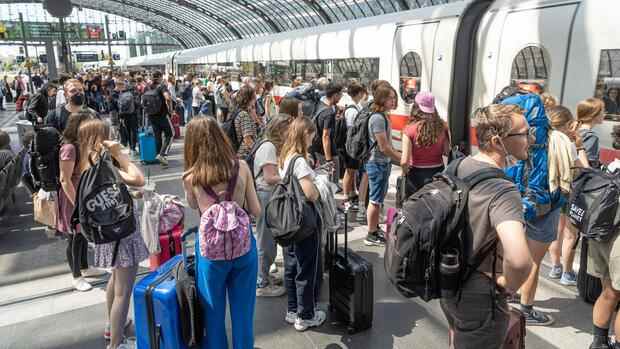The train wants to establish itself as an alternative to the plane on domestic German routes.
(Photo: IMAGO/Stefan Zeitz)
Frankfurt It is a special ICE that rolls into the long-distance train station at Frankfurt Airport on Monday afternoon. It bears the logo of the Star Alliance aviation alliance. The train is intended to document the start of a new era. Deutsche Bahn will be the first non-aviation company to join the Lufthansa alliance.
“Today combines the strengths of two different transport providers, opening the doors of Star Alliance beyond the airline world,” said Star Alliance CEO Jeffrey Goh after the train’s arrival. “We network our offers in such a way that we can optimally use the respective strengths of our modes of transport,” added Michael Peterson, Deutsche Bahn Board Member for Passenger Transport.
In view of the sometimes massive capacity bottlenecks and problems in both air and rail traffic, it is a partnership that raises questions. Can the new cooperation really succeed in luring passengers from the plane onto the train? Lufthansa board member Harry Hohmeister is convinced: “The successful Lufthansa Express Rail cooperation is an excellent example of this. Based on this, we are now consistently taking the next step.” According to Deutsche Bahn, more than twice as many air passengers boarded the train between April and June than in the same period of the previous year as a result of the cooperation with airlines.
Lufthansa and Deutsche Bahn have been working together for many years. In the spring of last year, both declared that they wanted to expand this partnership. Among other things, more Sprinters are to be used between important German cities – without many intermediate stops and with shorter travel times. Deutsche Bahn wants to offer an alternative for those flights where the passenger only wants to travel from one German city to another. The feeders to airports like the one in Frankfurt are also to be improved, for example through better coordination with the flight schedules.
Top jobs of the day
Find the best jobs now and
be notified by email.
The aviation industry and Deutsche Bahn are assuming that, should the transfer, including luggage, go smoothly and comfortably one day, 20 percent of domestic German passengers could be lured from jets to rail. Based on the pre-crisis year 2019, that would be 4.3 million passengers a year.
Great pressure from the new climate requirements
Additional passengers could be added via the Star Alliance. In the alliance, 26 airlines work together at more than 50 international hubs. In addition, the pressure to reduce and replace short-haul flights as much as possible is enormous.
With the “Fit for 55” program, the EU wants to reduce emissions of climate-damaging greenhouse gases by 55 percent by 2030 compared to 1990. Among other things, aviation should be prescribed fixed quotas for the admixture of synthetic kerosene (SAF).
Although the industry is in favor of using SAF, it fears significant disadvantages because these requirements are only intended to apply to European airlines. In her eyes, it is all the more important to show that there are other ways to make travel more climate-neutral. “Deutsche Bahn and Star Alliance are making a significant contribution to reducing CO2 emissions in the transport sector through attractive inner-German connections combined with simultaneous links to international travel chains,” said Peterson, board member at Deutsche Bahn.
>>Read about this: Lufthansa is fighting for a green future – these are the three main risks
For the customers of the alliance partners, traveling with both modes of transport should be much easier from August 1st. You get a combined ticket. Your luggage will be processed more quickly in the Airail Center at Frankfurt Airport. However, they will have to carry it there themselves for the time being, as both sides are still working on a more convenient solution.
Miles can now also be collected over the entire route with the bonus programs of the respective airlines. And anyone who is a Business or First Class customer can use the DB Lounges.
Star Alliance boss Goh announced that he wants to expand such partnerships with rail companies beyond Germany. The potential is there. Cooperation between trains and flights is also gaining in importance abroad. For example, the Lufthansa subsidiary Swiss, in cooperation with the Swiss SBB, has been offering a connection from Munich to Zurich Airport several times a day for a few days. So far, the so-called “Swiss Air Rail” has only existed within Switzerland.
If you book business or first class here, you automatically get a seat in first class with SBB. And there are miles: Frequent flyers earn up to 1,000 miles for bookings in economy and premium economy class. Business and First customers receive up to 1,500 miles.
More: Flight chaos: Lufthansa Supervisory Board holds extraordinary meeting
